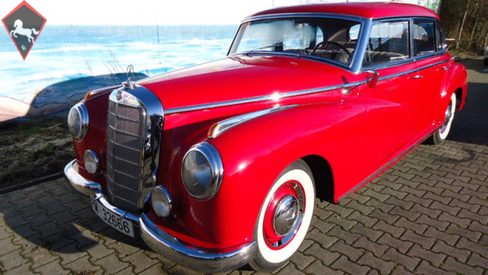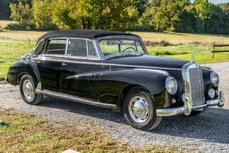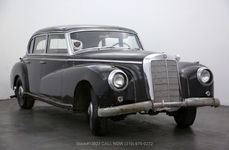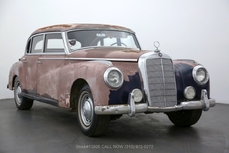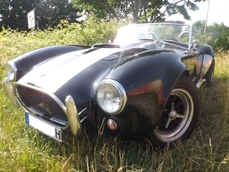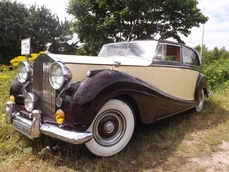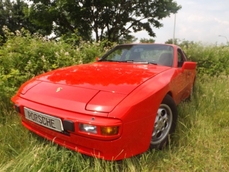Mercedes-Benz 300 W186 Adenauer 1952
General description :
Hiermit erlauben wir uns, ein ganz besonderes Fahrzeug zum Kauf anzubieten. Ganz besonders in zweierlei Hinsicht! Erstens ist es ein prachtvoller Mercedes-Benz 300 von 1952 in nahezu perfektem Zustand, völlig original und nachweislich gut gepflegt und gewartet. Völlig rostfrei, da er immer im sonnigen Spanien war ohne Regen, Schnee und Salz. Bis heute fährt, lenkt und bremst dieser wunderschöne Klassiker wie am ersten Tag und hat sich in den letzten Jahren als äußerst zuverlässig erwiesen. Die original rote Lackierung ist immer noch hochglänzend und in sehr gutem Zustand wie auch der Chrom und die komplette Innenausstattung. Und nun zum zweiten Grund, warum dieser Mercedes so außergewöhnlich ist: Dieser Mercedes 300 wurde bei Mercedes als Neufahrzeug bestellt, von keinem geringeren als dem spanischen General und Diktator Francisco Franko. Dieser nutzte das Fahrzeug für standesgemäße Ausfahrten bei hochrangigen Gastbesuchen aus dem Ausland und für eigene Zwecke. 7 Jahre lang war dieses Automobil sein offizielles Staatsfahrzeug und erwarb deshalb eine gewisse Berühmtheit durch seinen Eigentümer. Nach Ablauf dieser 7 Jahre vermachte Generalissimo Franco den Mercedes an seinen berühmtesten spanischen Ingenieur Dr. Jose Juan Cerdo Pons aus Palma de Mallorca, um seine besonderen Verdienste im infrastrukturellen Aufbau und der architektonischen Entwicklung Spaniens zu würdigen. Danach war dieser "Adenauer" das Chauffeurfahrzeug des Luxushotels San Sebastian in Palma und stand den Hotelgästen als exklusive Limousine zur Verfügung. Zuletzt kam dann dieser geschichtsträchtige Mercedes wieder nach Deutschland zum jetzigem Eigentümer, der ihn bis heute wie einen Schatz gehegt und gepflegt hat. Aber nicht nur das Auto, auch sein Eigentümer wurde immer älter und es ist an der Zeit, einen würdigen Nachfolger zu finden, bei welchem es dieses herrliche Fahrzeug weiterhin gut hat.
WENN NOCH WEITERE FAHRZEUGE DIESER ART INTERESSANT SEIN SOLLTEN BITTE EINFACH "FANTASTISCHE FAHRZEUGE" GOOGLE´N. WIR SIND SOFORT DER ERSTE EINTRAG !
Telefonischer Kontakt wird sofort bearbeitet. E-mails dauern etwas länger. (Bitte eigene Telefonnummer angeben)
Verkauf im Kundenauftrag ! Irrtümer vorbehalten.
1952 Mercedes-Benz 300 W186 Adenauer is listed for sale on ClassicDigest in Rudolf-Diesel-Straße 2DE-40822 Mettmann for €98850.
Car Facts
Car type : Car Make : Mercedes-Benz Model : 300 W186 Adenauer Engine size : 0.0 Model Year : 1952 Sub type : Sedan Location : Rudolf-Diesel-Straße 2DE-40822 Mettmann Vehicle Registration : Undefined
98850 €
Seller Information
Fantastische Fahrzeuge - Michael Fröhlich - Agentur für Oldtimer
Fantastische Fahrzeuge - Michael Fröhlich - Agentur für Oldtimer
+49 (0)211 322809
Fantastische Fahrzeuge - Michael Fröhlich - Agentur für Oldtimer
+49 (0)211 322809
People who viewed this Mercedes-Benz 300 W186 Adenauer also viewed similar Mercedes-Benz listed at ClassicDigest
Other cars listed for sale by this seller
About Mercedes-Benz
In the annals of automotive history, the journey of Mercedes-Benz is a tale that unfolds with the ingenuity of its founding pioneers. In the year 1886, Karl Benz crafted the Benz Patent Motorwagen, a creation that would go down in history as the world's inaugural automobile. Unbeknownst to him, this moment marked the genesis of what would evolve into the most illustrious premium car manufacturer globally. The financial underpinning of this pioneering venture, interestingly, was provided by Karl Benz's wife, Bertha Benz, demonstrating a remarkable partnership that would set the tone for Mercedes-Benz's legacy.A parallel narrative emerged not far away, as Daimler-Motoren-Gesellschaft, founded by Gottlieb Daimler and Wilhelm Maybach, entered the scene. In 1901, they unveiled their automobile under the now-famous moniker "Mercedes," meaning "godsend" in Spanish. This name was bestowed upon the car at the behest of Emil Jellinek's daughter, the distributor for Daimler-Motoren-Gesellschaft. The wheels of innovation were set in motion.
Fast forward to 1926, a pivotal year that witnessed the merger of Daimler with Benz & Cie., culminating in the birth of Daimler-Benz. The amalgamation saw the adoption of "Mercedes-Benz" as the distinguished trademark for their automobiles, fusing the legacies of two visionary entities into one.
Contrary to perceptions of conservatism, the trajectory of Daimler-Benz unfolds as a chronicle of industry firsts. From the introduction of the honeycomb radiator to the float carburetor, and the pioneering implementation of four-wheel brakes in 1924, Daimler-Benz consistently pushed the boundaries of automotive innovation. The diesel-powered Mercedes-Benz 260 D in 1936 marked the inception of diesel engines in passenger cars. The iconic Mercedes-Benz 300SL Gullwing made history as the first car with direct fuel injection, albeit the Gutbrod's tiny 2-stroke engine can claim precedence.
Safety innovations became a hallmark, with Béla Barényi's patented safety cell design in the "Ponton"-models in 1951, featuring front and rear crumple zones. The W116 450SEL 6.9 saw the introduction of the Anti-Lock Brake system (ABS), another pioneering safety feature. From the first production airbags and beyond, the legacy of "firsts" continued to be etched into the fabric of Daimler-Benz.
Over its centennial journey, Mercedes-Benz has not merely produced cars but has sculpted automotive icons. The SSKL, 710 SSK Trossi Roadster, 770K Grosser, 540K Spezial Roadster, 300SL Gullwing, w100 600 Pullman, w111 280SE 3.5 Flachkühler, w113 230SL Pagoda, w109 300 SEL 6.3, and w201 2.3-16 Cosworth stand testament to the brand's commitment to engineering excellence.
The roaring Silver Arrows, or "Silberpfeile," including the W 25, W 125, W154, W165, and W196, created a legacy of dominance on the racetrack. These machines were not merely cars; they were expressions of precision, speed, and an indomitable spirit that left their competitors in the dust.
As Mercedes-Benz marches into the future, it does so not just as an automaker but as a custodian of a legacy, a torchbearer of innovation, and a beacon of automotive excellence. The road ahead is sure to witness the continued fusion of cutting-edge technology, timeless design, and an unwavering commitment to setting new standards in the world of automobiles.
One luminary figure who left an indelible mark was Béla Barényi, often heralded as the "father of passive safety" for his pioneering work in safety engineering. His patented safety cell design, featuring front and rear crumple zones, became a hallmark of Mercedes-Benz's commitment to occupant safety, setting new standards that reverberated throughout the automotive world.
Moving through the chronicles, the collaborative genius of Wilhelm Maybach, alongside Gottlieb Daimler, laid the foundation for Daimler-Motoren-Gesellschaft. Their innovations not only birthed the first Mercedes but established a culture of relentless pursuit of technological excellence that remains integral to Mercedes-Benz's DNA.
In the post-merger era of 1926, Ferdinand Porsche emerged as a prominent figure within Mercedes-Benz. His work on the Mercedes-Benz S-Type, a supercharged race car, garnered acclaim and set the stage for a legacy that extended far beyond the marque. Porsche's impact would later extend to his eponymous company, but his influence at Mercedes-Benz during those formative years was pivotal.
As the 20th century progressed, the legendary Rudolf Uhlenhaut emerged as a key figure. Uhlenhaut, an accomplished engineer and the driving force behind the iconic Silver Arrows, played a crucial role in Mercedes-Benz's dominance in motorsports. His engineering prowess and attention to detail were instrumental in creating some of the most formidable racing cars of the era.
In the latter half of the century, figures like Bruno Sacco, the head of design at Mercedes-Benz from 1975 to 1999, left an indelible imprint on the brand's aesthetic identity. Sacco's design philosophy, characterized by clean lines and timeless elegance, shaped iconic models like the W126 S-Class and the W201 190E, solidifying Mercedes-Benz's reputation for luxury and sophistication.
The narrative would be incomplete without acknowledging the contributions of engineers like Hans Scherenberg, whose leadership in the 1970s ushered in a new era of technological innovation at Mercedes-Benz. Scherenberg's tenure saw the development of groundbreaking technologies, including the Anti-Lock Brake system (ABS) and the introduction of airbags in production cars.
